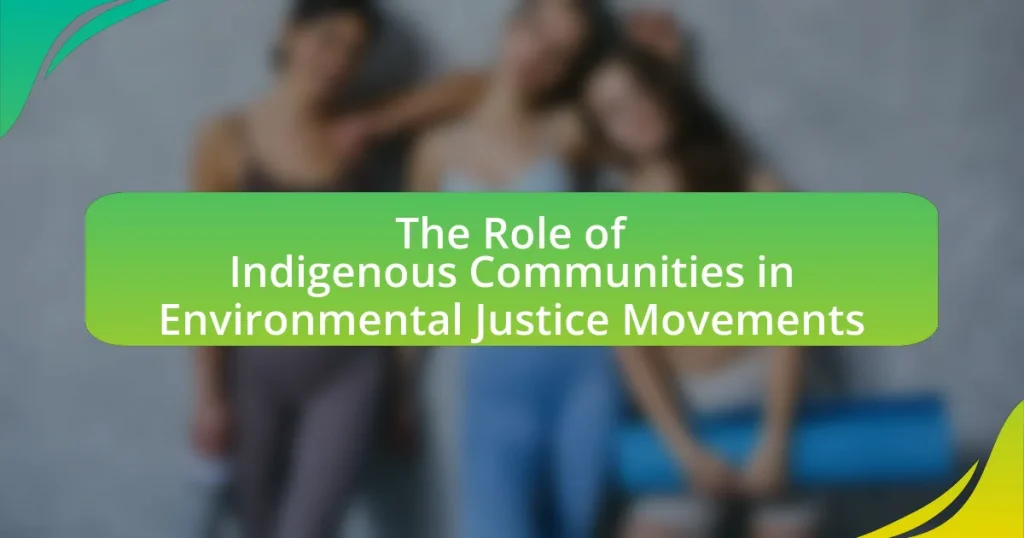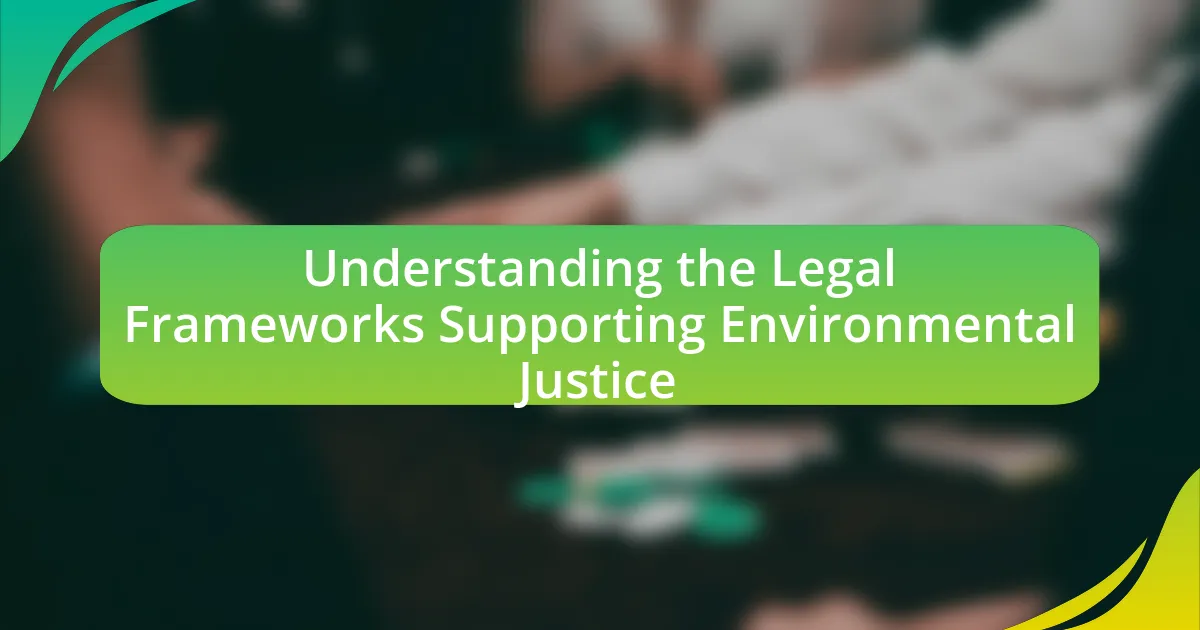Indigenous communities are integral to environmental justice movements, advocating for the protection of their ancestral lands and natural resources while facing disproportionate impacts from environmental degradation. They define environmental justice as the equitable distribution of environmental benefits and burdens, emphasizing the importance of traditional ecological knowledge in sustainable land management. The article explores the principles guiding Indigenous perspectives on environmental justice, the challenges they encounter, and the strategies they employ to engage in advocacy. It highlights successful case studies of Indigenous-led initiatives and discusses the role of education and policy changes in supporting Indigenous involvement in environmental justice efforts.
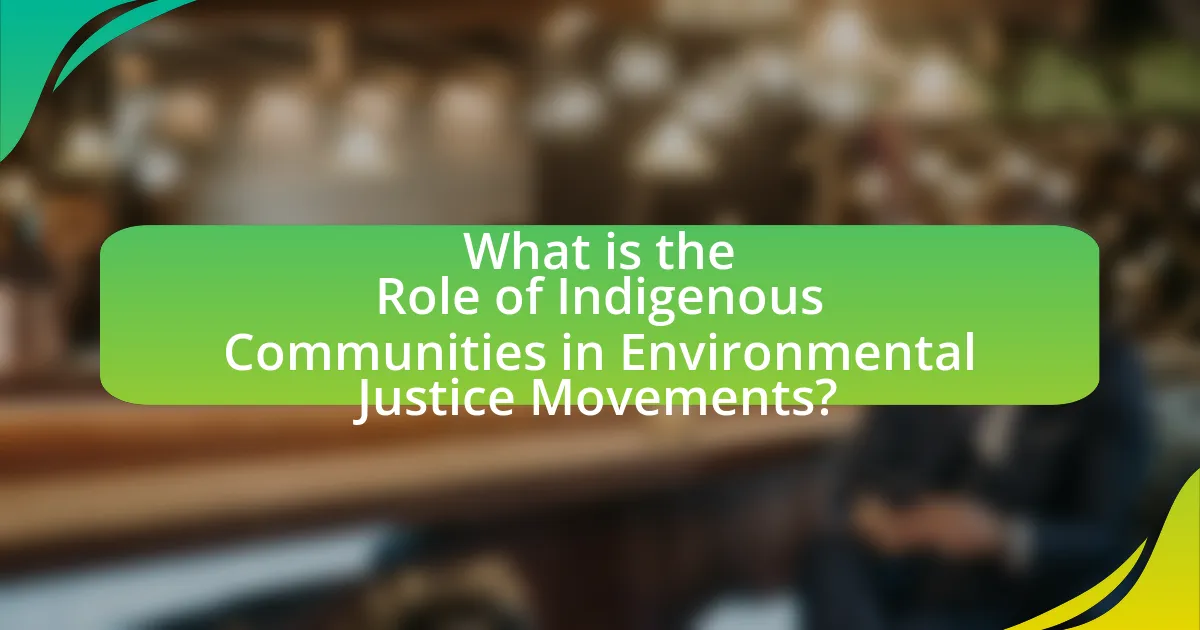
What is the Role of Indigenous Communities in Environmental Justice Movements?
Indigenous communities play a crucial role in environmental justice movements by advocating for the protection of their ancestral lands and natural resources. These communities often face disproportionate impacts from environmental degradation, such as pollution and climate change, which threaten their health, culture, and livelihoods. For instance, the Standing Rock Sioux Tribe’s opposition to the Dakota Access Pipeline highlighted the intersection of indigenous rights and environmental justice, drawing global attention to the need for sustainable practices and respect for indigenous sovereignty. Furthermore, indigenous knowledge systems contribute valuable insights into sustainable land management and biodiversity conservation, reinforcing their essential role in shaping effective environmental policies.
How do Indigenous communities define environmental justice?
Indigenous communities define environmental justice as the equitable distribution of environmental benefits and burdens, emphasizing the protection of their ancestral lands and resources. This definition is rooted in the belief that environmental health is intrinsically linked to cultural identity and community well-being. Indigenous perspectives highlight the importance of traditional ecological knowledge and the need for meaningful participation in decision-making processes regarding land use and environmental policies. For instance, the United Nations Declaration on the Rights of Indigenous Peoples recognizes the rights of Indigenous peoples to maintain and strengthen their distinct spiritual relationship with their traditionally owned or otherwise occupied and used lands, territories, waters, and coastal seas. This framework underscores the necessity of respecting Indigenous sovereignty and ensuring that their voices are integral to environmental justice initiatives.
What principles guide Indigenous perspectives on environmental justice?
Indigenous perspectives on environmental justice are guided by principles such as interconnectedness, respect for traditional knowledge, and the protection of land and resources for future generations. These principles emphasize the relationship between people and the environment, recognizing that all elements of nature are interconnected and that harming one aspect affects the whole ecosystem. Respect for traditional ecological knowledge, which has been developed over centuries, informs sustainable practices and conservation efforts. Additionally, Indigenous communities advocate for the stewardship of their ancestral lands, asserting that environmental justice includes the right to protect their territories from exploitation and degradation, ensuring that future generations inherit a healthy environment.
How do cultural beliefs influence Indigenous approaches to environmental issues?
Cultural beliefs significantly influence Indigenous approaches to environmental issues by fostering a deep connection to the land and emphasizing stewardship. Indigenous cultures often view the environment as a living entity, which shapes their practices and policies regarding natural resource management. For instance, many Indigenous communities incorporate traditional ecological knowledge, which is rooted in cultural beliefs, into their environmental decision-making processes. This knowledge includes sustainable practices that have been passed down through generations, such as controlled burns to manage forests or seasonal harvesting techniques that protect biodiversity. Research shows that these culturally informed practices can lead to more effective conservation outcomes, as seen in studies conducted by the United Nations Environment Programme, which highlight the success of Indigenous-led initiatives in preserving ecosystems.
Why are Indigenous communities crucial to environmental justice movements?
Indigenous communities are crucial to environmental justice movements because they possess traditional ecological knowledge and a deep connection to their ancestral lands. This knowledge enables them to advocate for sustainable practices and protect biodiversity, which is essential for environmental health. For instance, Indigenous-led initiatives have been shown to effectively manage natural resources, as evidenced by the success of community-managed forests in countries like Brazil, where deforestation rates are significantly lower in Indigenous territories compared to non-Indigenous areas. Furthermore, Indigenous peoples often face disproportionate impacts from environmental degradation, making their involvement vital for addressing systemic inequalities and ensuring that their rights and voices are included in environmental decision-making processes.
What unique knowledge do Indigenous communities bring to environmental advocacy?
Indigenous communities bring traditional ecological knowledge (TEK) to environmental advocacy, which encompasses a deep understanding of local ecosystems developed over generations. This knowledge includes sustainable land management practices, biodiversity conservation techniques, and insights into climate resilience that are often overlooked in mainstream environmental strategies. For instance, Indigenous fire management practices have been shown to reduce wildfire risks and promote ecosystem health, as evidenced by studies highlighting the effectiveness of controlled burns used by Indigenous peoples in Australia and North America. This unique perspective not only enhances environmental advocacy efforts but also contributes to more holistic and culturally relevant approaches to conservation and sustainability.
How do Indigenous communities contribute to biodiversity conservation?
Indigenous communities contribute to biodiversity conservation through traditional ecological knowledge and sustainable land management practices. These communities have developed a deep understanding of local ecosystems over generations, which informs their practices in agriculture, hunting, and resource management. For example, Indigenous fire management techniques, such as controlled burns, have been shown to enhance biodiversity and reduce the risk of larger wildfires, as evidenced by studies in Australia and North America. Furthermore, Indigenous-led conservation initiatives, such as the establishment of protected areas, have proven effective in preserving habitats and species, with research indicating that Indigenous-managed lands often exhibit higher biodiversity levels compared to other land management approaches.
What challenges do Indigenous communities face in environmental justice movements?
Indigenous communities face significant challenges in environmental justice movements, primarily due to systemic marginalization and lack of recognition of their rights. These communities often contend with legal barriers that prevent them from asserting land rights, as many governments prioritize industrial development over Indigenous land claims. For instance, the United Nations Declaration on the Rights of Indigenous Peoples emphasizes the need for free, prior, and informed consent, yet many Indigenous groups report that their voices are overlooked in decision-making processes regarding resource extraction and environmental policies. Additionally, Indigenous communities frequently experience socio-economic disadvantages, which limit their capacity to mobilize and advocate effectively for environmental justice. This combination of legal, political, and economic challenges undermines their ability to protect their lands and resources from environmental degradation.
How does colonial history impact Indigenous participation in environmental justice?
Colonial history significantly impacts Indigenous participation in environmental justice by establishing systemic inequalities and marginalization that persist today. Historical land dispossession, cultural erasure, and legal frameworks imposed during colonial times have led to a lack of recognition of Indigenous rights and sovereignty over traditional lands. For instance, treaties often signed under duress or misrepresentation have resulted in ongoing disputes over land use and resource management, limiting Indigenous communities’ ability to engage effectively in environmental justice initiatives. Furthermore, colonial narratives have historically framed Indigenous knowledge as inferior, undermining the value of traditional ecological practices that are crucial for sustainable environmental stewardship. This legacy creates barriers to collaboration and recognition in contemporary environmental movements, as Indigenous voices are often sidelined in decision-making processes that affect their lands and resources.
What legal and political barriers hinder Indigenous advocacy efforts?
Legal and political barriers that hinder Indigenous advocacy efforts include restrictive legislation, lack of recognition of Indigenous rights, and inadequate consultation processes. Restrictive legislation often limits the ability of Indigenous communities to assert their rights over land and resources, as seen in various countries where laws prioritize corporate interests over Indigenous sovereignty. The lack of recognition of Indigenous rights in national and international law further complicates advocacy efforts, as it undermines the legitimacy of Indigenous claims and voices. Additionally, inadequate consultation processes, which fail to involve Indigenous communities meaningfully in decision-making, lead to decisions that disregard their perspectives and needs, exemplified by numerous cases where environmental assessments are conducted without proper engagement with Indigenous peoples.
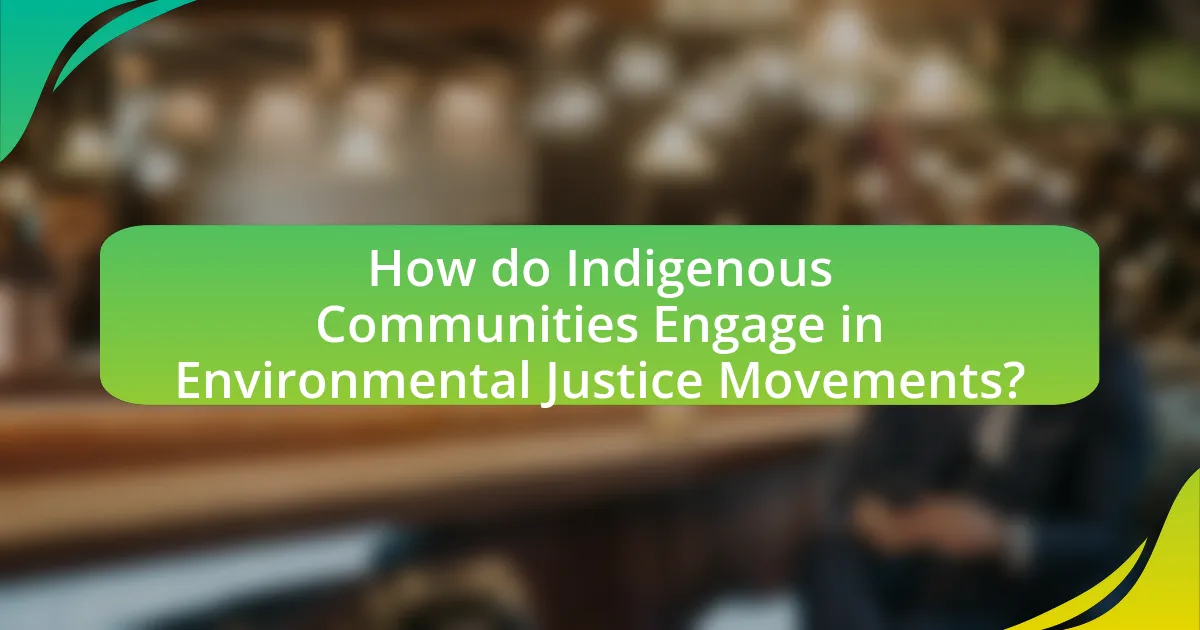
How do Indigenous Communities Engage in Environmental Justice Movements?
Indigenous communities engage in environmental justice movements through advocacy, legal action, and grassroots organizing to protect their lands and resources. They often highlight the disproportionate impact of environmental degradation on their communities, using traditional ecological knowledge to inform sustainable practices. For instance, the Standing Rock Sioux Tribe’s opposition to the Dakota Access Pipeline exemplifies how Indigenous groups mobilize public support and legal challenges to defend their rights and environment. Additionally, Indigenous-led initiatives, such as the Indigenous Environmental Network, work to raise awareness about climate change and promote policies that respect Indigenous sovereignty and environmental stewardship.
What strategies do Indigenous communities use to advocate for environmental justice?
Indigenous communities advocate for environmental justice through strategies such as legal action, grassroots organizing, and cultural revitalization. Legal action includes filing lawsuits against corporations and governments to protect land and resources, exemplified by the Standing Rock Sioux Tribe’s opposition to the Dakota Access Pipeline, which highlighted the legal rights of Indigenous peoples. Grassroots organizing involves mobilizing community members to raise awareness and engage in protests, as seen in various campaigns against environmental degradation affecting their territories. Cultural revitalization emphasizes the importance of traditional ecological knowledge and practices, which are integrated into advocacy efforts to promote sustainable land management and environmental stewardship. These strategies collectively empower Indigenous communities to assert their rights and influence environmental policies.
How do grassroots movements empower Indigenous voices in environmental issues?
Grassroots movements empower Indigenous voices in environmental issues by providing platforms for advocacy, mobilizing community engagement, and amplifying traditional ecological knowledge. These movements often prioritize Indigenous perspectives, allowing communities to assert their rights and influence environmental policies. For instance, the Standing Rock Sioux Tribe’s opposition to the Dakota Access Pipeline showcased how grassroots organizing can unite diverse groups in support of Indigenous sovereignty and environmental protection. This mobilization led to increased visibility of Indigenous issues in mainstream media and policy discussions, demonstrating the effectiveness of grassroots efforts in elevating Indigenous voices.
What role do partnerships with non-Indigenous organizations play in these movements?
Partnerships with non-Indigenous organizations play a crucial role in environmental justice movements by amplifying Indigenous voices and facilitating access to resources and networks. These collaborations often lead to increased visibility for Indigenous issues, enabling broader public awareness and support. For instance, partnerships can provide technical expertise, funding, and advocacy platforms that strengthen Indigenous-led initiatives, such as the protection of sacred lands and water rights. Research indicates that successful collaborations, like those seen in the Standing Rock protests against the Dakota Access Pipeline, demonstrate how non-Indigenous allies can enhance the effectiveness of Indigenous movements by leveraging their influence and resources to challenge systemic injustices.
How do Indigenous-led initiatives address environmental injustices?
Indigenous-led initiatives address environmental injustices by prioritizing traditional ecological knowledge and advocating for the rights of Indigenous peoples in environmental decision-making. These initiatives often focus on protecting sacred lands, water sources, and biodiversity, which are crucial for both cultural identity and ecological health. For example, the Standing Rock Sioux Tribe’s opposition to the Dakota Access Pipeline highlighted the environmental risks posed to their water supply and sacred sites, drawing national attention to the broader issues of Indigenous rights and environmental protection. Additionally, research indicates that Indigenous-managed lands often exhibit higher biodiversity and better ecological outcomes, demonstrating the effectiveness of their stewardship practices in combating environmental degradation.
What are some successful case studies of Indigenous environmental justice initiatives?
Successful case studies of Indigenous environmental justice initiatives include the Lubicon Lake Band’s fight against oil extraction in Alberta, Canada, which resulted in increased awareness and legal recognition of Indigenous land rights. Another example is the Standing Rock Sioux Tribe’s opposition to the Dakota Access Pipeline, which garnered international support and highlighted the importance of protecting water resources and sacred sites. Additionally, the Yurok Tribe in California successfully restored salmon populations through habitat restoration efforts, demonstrating the effectiveness of traditional ecological knowledge in environmental management. These cases illustrate the significant impact Indigenous communities can have on environmental justice through advocacy and sustainable practices.
How do these initiatives impact local ecosystems and communities?
Indigenous-led initiatives significantly enhance local ecosystems and communities by promoting sustainable practices and preserving biodiversity. These initiatives often incorporate traditional ecological knowledge, which has been shown to improve land management and resource conservation. For instance, studies indicate that areas managed by Indigenous communities often exhibit higher levels of biodiversity compared to those under conventional management, as seen in the work of the Indigenous Peoples’ Biocultural Climate Change Assessment, which highlights the effectiveness of Indigenous stewardship in maintaining ecological balance. Additionally, these initiatives foster community resilience by empowering local populations, creating economic opportunities through sustainable practices, and strengthening cultural identity, as evidenced by the success of community-led conservation projects in various regions.
What role does traditional ecological knowledge play in environmental justice?
Traditional ecological knowledge (TEK) plays a crucial role in environmental justice by providing insights into sustainable practices and resource management that have been developed over generations by Indigenous communities. TEK encompasses the understanding of local ecosystems, biodiversity, and the impacts of environmental changes, which can inform policies and practices aimed at achieving equitable environmental outcomes. For instance, studies have shown that integrating TEK into environmental management can lead to more effective conservation strategies, as evidenced by the successful restoration of ecosystems in various regions when Indigenous knowledge is utilized alongside scientific approaches. This integration not only empowers Indigenous communities but also promotes social equity by recognizing their rights and contributions to environmental stewardship.
How is traditional ecological knowledge integrated into modern environmental practices?
Traditional ecological knowledge (TEK) is integrated into modern environmental practices through collaborative management approaches that incorporate indigenous perspectives and methods. This integration is evident in various initiatives, such as co-management agreements between indigenous communities and government agencies, which leverage TEK for sustainable resource management. For example, the use of TEK in fisheries management has been shown to enhance biodiversity and improve fish stocks, as demonstrated by the successful practices of the Haida Nation in British Columbia, where traditional practices have led to the recovery of herring populations. Additionally, TEK informs climate adaptation strategies, as seen in the work of the Inuit in Canada, who utilize their knowledge of local ecosystems to develop effective responses to climate change impacts. These examples illustrate the practical application of TEK in contemporary environmental practices, reinforcing its value in achieving ecological sustainability.
What benefits arise from combining traditional knowledge with scientific approaches?
Combining traditional knowledge with scientific approaches enhances environmental management and sustainability. Traditional knowledge, often rooted in centuries of experience, provides insights into local ecosystems, biodiversity, and sustainable practices that may not be captured by scientific methods alone. For instance, indigenous practices in agriculture, such as crop rotation and polyculture, have been shown to improve soil health and increase resilience to climate change, as evidenced by studies like “Indigenous Knowledge and Climate Change” by the United Nations Educational, Scientific and Cultural Organization (UNESCO). This integration leads to more holistic and effective solutions for environmental challenges, fostering collaboration between communities and scientists to address issues like biodiversity loss and climate adaptation.
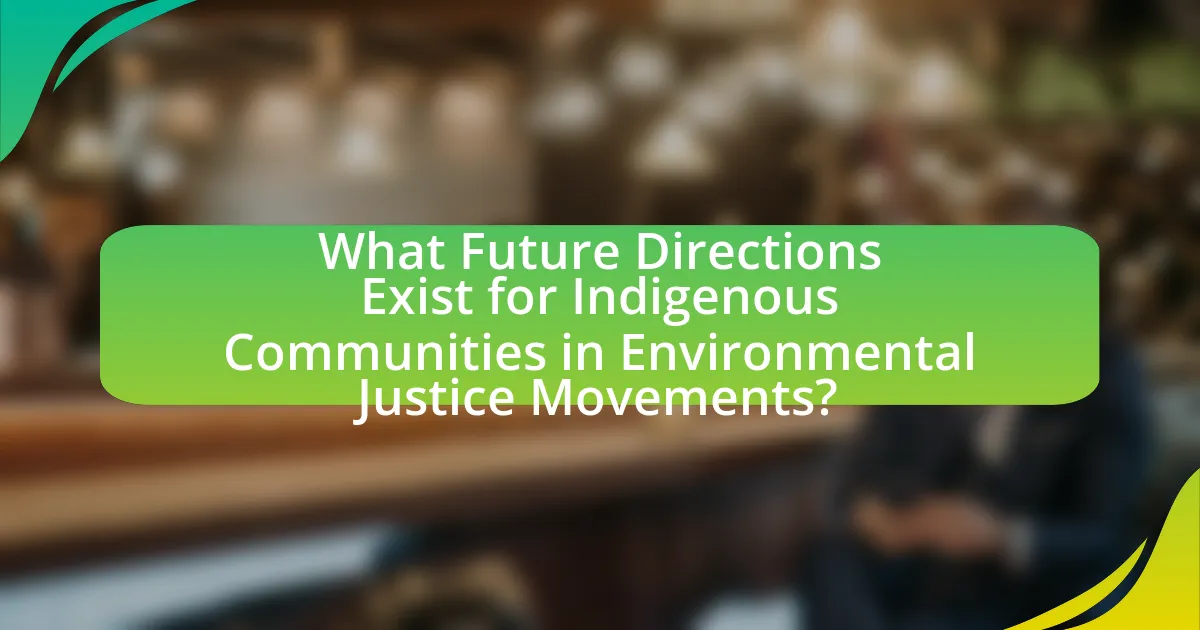
What Future Directions Exist for Indigenous Communities in Environmental Justice Movements?
Future directions for Indigenous communities in environmental justice movements include increased collaboration with non-Indigenous allies, enhanced legal recognition of Indigenous rights, and the integration of traditional ecological knowledge into environmental policies. These directions are supported by the growing acknowledgment of Indigenous sovereignty and the effectiveness of grassroots activism, as seen in movements like Standing Rock, where Indigenous voices played a crucial role in opposing pipeline projects. Furthermore, research indicates that Indigenous-led initiatives often lead to more sustainable environmental practices, highlighting the importance of their participation in shaping future environmental policies.
How can policy changes support Indigenous involvement in environmental justice?
Policy changes can support Indigenous involvement in environmental justice by recognizing and affirming Indigenous rights to land and resources, thereby enabling their participation in decision-making processes. For instance, the United Nations Declaration on the Rights of Indigenous Peoples emphasizes the importance of obtaining free, prior, and informed consent from Indigenous communities before any development projects occur on their lands. This legal framework empowers Indigenous groups to advocate for their environmental interests and ensures that their traditional ecological knowledge is integrated into environmental policies. Additionally, policies that allocate funding for Indigenous-led conservation initiatives can enhance their capacity to address environmental issues effectively, as seen in various successful community-led projects across North America.
What specific policies can enhance Indigenous rights and environmental protections?
Specific policies that can enhance Indigenous rights and environmental protections include the recognition of Indigenous land rights, implementation of Free, Prior, and Informed Consent (FPIC), and the establishment of co-management agreements for natural resources. Recognizing Indigenous land rights ensures that Indigenous communities have legal ownership and control over their ancestral territories, which is crucial for environmental stewardship. FPIC mandates that Indigenous peoples must be consulted and give consent before any projects affecting their lands are initiated, thereby protecting their rights and interests. Co-management agreements allow Indigenous communities to share authority and responsibility in managing natural resources, leading to more sustainable practices that align with traditional ecological knowledge. These policies are supported by international frameworks such as the United Nations Declaration on the Rights of Indigenous Peoples (UNDRIP), which emphasizes the importance of Indigenous rights in environmental governance.
How can governments better collaborate with Indigenous communities on environmental issues?
Governments can better collaborate with Indigenous communities on environmental issues by establishing formal partnerships that respect Indigenous knowledge and governance systems. Such partnerships should include co-management agreements for natural resources, ensuring that Indigenous voices are integral in decision-making processes. For instance, the United Nations Declaration on the Rights of Indigenous Peoples emphasizes the importance of free, prior, and informed consent, which mandates that governments engage Indigenous communities before undertaking projects that affect their lands. This approach not only acknowledges Indigenous rights but also leverages traditional ecological knowledge, which has been shown to enhance biodiversity conservation and sustainable resource management.
What role does education play in advancing Indigenous environmental justice?
Education plays a crucial role in advancing Indigenous environmental justice by empowering Indigenous communities with knowledge and skills to advocate for their rights and protect their lands. Through education, Indigenous peoples gain awareness of environmental issues, legal frameworks, and sustainable practices, enabling them to engage effectively in environmental decision-making processes. For instance, programs that integrate traditional ecological knowledge with contemporary environmental science have been shown to enhance community resilience and advocacy efforts, as evidenced by initiatives like the Indigenous Environmental Network, which promotes education as a tool for activism. This combination of knowledge fosters a deeper understanding of the interconnectedness of social, cultural, and environmental justice, ultimately leading to more effective advocacy for Indigenous rights and environmental protection.
How can educational programs raise awareness about Indigenous environmental issues?
Educational programs can raise awareness about Indigenous environmental issues by integrating Indigenous knowledge systems and perspectives into their curricula. This approach not only highlights the unique relationship Indigenous communities have with their environments but also emphasizes the importance of traditional ecological knowledge in addressing contemporary environmental challenges. For instance, programs that include case studies on Indigenous-led conservation efforts, such as the protection of sacred lands or sustainable resource management practices, can effectively illustrate the impact of Indigenous stewardship on biodiversity and ecosystem health. Research shows that incorporating Indigenous perspectives in education fosters greater respect for cultural diversity and environmental sustainability, as evidenced by studies conducted by the National Congress of American Indians, which highlight the positive outcomes of such educational initiatives in promoting environmental justice.
What resources are available for Indigenous youth to engage in environmental advocacy?
Indigenous youth can access various resources to engage in environmental advocacy, including educational programs, mentorship opportunities, and funding initiatives. Organizations such as the Indigenous Environmental Network provide training and resources focused on environmental justice and advocacy skills. Additionally, programs like the First Nations Development Institute offer grants specifically for youth-led environmental projects. These resources empower Indigenous youth to participate actively in environmental advocacy, fostering leadership and community engagement.
What practical steps can individuals take to support Indigenous communities in environmental justice?
Individuals can support Indigenous communities in environmental justice by actively engaging in advocacy, education, and collaboration. Advocacy involves participating in campaigns that promote Indigenous rights and environmental protections, such as supporting legislation that recognizes Indigenous land sovereignty. Education can be pursued by learning about Indigenous histories, cultures, and environmental practices, which fosters respect and understanding. Collaboration with Indigenous leaders and organizations on environmental projects ensures that their knowledge and perspectives are integrated into solutions. For instance, the United Nations Declaration on the Rights of Indigenous Peoples emphasizes the importance of Indigenous participation in decision-making processes related to their lands and resources, highlighting the need for inclusive approaches to environmental justice.
How can community members advocate for Indigenous rights in environmental policies?
Community members can advocate for Indigenous rights in environmental policies by actively participating in local governance and policy-making processes. Engaging in public consultations, attending town hall meetings, and forming coalitions with Indigenous leaders can amplify their voices and concerns. Research indicates that inclusive decision-making leads to more equitable environmental policies, as seen in the 2016 United Nations Declaration on the Rights of Indigenous Peoples, which emphasizes the importance of Indigenous participation in environmental governance. By leveraging these platforms, community members can ensure that Indigenous perspectives are integrated into environmental policies, thereby promoting justice and sustainability.
What actions can individuals take to promote Indigenous-led environmental initiatives?
Individuals can promote Indigenous-led environmental initiatives by actively supporting Indigenous rights and sovereignty. This can be achieved through advocacy for policies that recognize and uphold Indigenous land rights, which are crucial for effective environmental stewardship. For instance, research shows that Indigenous-managed lands often have lower deforestation rates and higher biodiversity, highlighting the effectiveness of their traditional ecological knowledge. Additionally, individuals can participate in or support campaigns that amplify Indigenous voices in environmental decision-making processes, ensuring that their perspectives are included in discussions about land use and conservation. Engaging in partnerships with Indigenous organizations and contributing to their projects can also enhance the visibility and impact of these initiatives.
